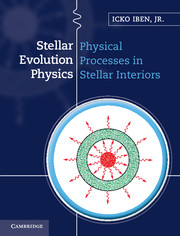Book contents
- Frontmatter
- Contents
- Preface
- Part I Introduction and overview
- Part II Basic physical processes in stellar interiors
- 3 Properties of and physical processes in main sequence stars–order of magnitude estimates
- 4 Statistical mechanics, thermodynamics, and equations of state
- 5 Polytropes and single zone models
- 6 Hydrogen-burning reactions and energy-generation rates
- 7 Photon–matter interaction probabilities, absorption cross sections, and opacity
- 8 Equations of stellar evolution and methods of solution
- Part III Pre-main sequence, main sequence, and shell hydrogen-burning evolution of single stars
- Index
- References
7 - Photon–matter interaction probabilities, absorption cross sections, and opacity
from Part II - Basic physical processes in stellar interiors
Published online by Cambridge University Press: 05 December 2012
- Frontmatter
- Contents
- Preface
- Part I Introduction and overview
- Part II Basic physical processes in stellar interiors
- 3 Properties of and physical processes in main sequence stars–order of magnitude estimates
- 4 Statistical mechanics, thermodynamics, and equations of state
- 5 Polytropes and single zone models
- 6 Hydrogen-burning reactions and energy-generation rates
- 7 Photon–matter interaction probabilities, absorption cross sections, and opacity
- 8 Equations of stellar evolution and methods of solution
- Part III Pre-main sequence, main sequence, and shell hydrogen-burning evolution of single stars
- Index
- References
Summary
An understanding of the manner in which matter and radiation interact is crucial for understanding how the structure of a star is influenced by the flow of energy. In this chapter, the physics of three processes whereby photons are absorbed by electrons interacting through the Coulomb potential with heavy ions is examined. The three processes are photo-ionization, inverse bremsstrahlung on free electrons, and transitions between bound atomic levels. Approximations to the cross sections for these processes are derived and the manner in which calculated cross sections are weighted to obtain the opacity under conditions of thermodynamic equilibrium is described and utilized in sample calculations of the opacity. Of primary interest here is not a presentation of definitive results, but rather a conceptual understanding of the basic ingredients of a quantitative calculation of absorption cross sections and of the related opacity.
An excellent monograph which describes the processes rigorously is The Quantum Theory of Radiation by Walter Heitler (1954), a pedagogically excellent text of relevance is Quantum Mechanics by Leonard I. Schiff (1949), and a delightfully intuitive approach to the calculation of transition probabilities is presented in Quantum Electrodynamics, based on lectures by Richard P. Feynman (1962). It would be remiss not to acknowledge the debt which the theory of quantum electrodynamics owes to Michael Faraday (1791–1867) and James Clerk Maxwell (1831–1879), the principle inventors of classical electrodynamics, as described in Maxwell's two volume Treatise on Electricity and Magnetism (1873).
- Type
- Chapter
- Information
- Stellar Evolution Physics , pp. 298 - 434Publisher: Cambridge University PressPrint publication year: 2012



